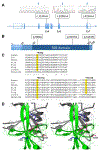SSBP1 mutations in dominant optic atrophy with variable retinal degeneration
- PMID: 31298765
- PMCID: PMC8855788
- DOI: 10.1002/ana.25550
SSBP1 mutations in dominant optic atrophy with variable retinal degeneration
Abstract
Objective: Autosomal dominant optic atrophy (ADOA) starts in early childhood with loss of visual acuity and color vision deficits. OPA1 mutations are responsible for the majority of cases, but in a portion of patients with a clinical diagnosis of ADOA, the cause remains unknown. This study aimed to identify novel ADOA-associated genes and explore their causality.
Methods: Linkage analysis and sequencing were performed in multigeneration families and unrelated patients to identify disease-causing variants. Functional consequences were investigated in silico and confirmed experimentally using the zebrafish model.
Results: We defined a new ADOA locus on 7q33-q35 and identified 3 different missense variants in SSBP1 (NM_001256510.1; c.113G>A [p.(Arg38Gln)], c.320G>A [p.(Arg107Gln)] and c.422G>A [p.(Ser141Asn)]) in affected individuals from 2 families and 2 singletons with ADOA and variable retinal degeneration. The mutated arginine residues are part of a basic patch that is essential for single-strand DNA binding. The loss of a positive charge at these positions is very likely to lower the affinity of SSBP1 for single-strand DNA. Antisense-mediated knockdown of endogenous ssbp1 messenger RNA (mRNA) in zebrafish resulted in compromised differentiation of retinal ganglion cells. A similar effect was achieved when mutated mRNAs were administered. These findings point toward an essential role of ssbp1 in retinal development and the dominant-negative nature of the identified human variants, which is consistent with the segregation pattern observed in 2 multigeneration families studied.
Interpretation: SSBP1 is an essential protein for mitochondrial DNA replication and maintenance. Our data have established pathogenic variants in SSBP1 as a cause of ADOA and variable retinal degeneration. ANN NEUROL 2019;86:368-383.
© 2019 American Neurological Association.
Conflict of interest statement
Conflicts of Interest
No conflicts to report.
Figures








Similar articles
-
SSBP1-Disease Update: Expanding the Genetic and Clinical Spectrum, Reporting Variable Penetrance and Confirming Recessive Inheritance.Invest Ophthalmol Vis Sci. 2021 Dec 1;62(15):12. doi: 10.1167/iovs.62.15.12. Invest Ophthalmol Vis Sci. 2021. PMID: 34905022 Free PMC article.
-
The importance of genome sequencing: unraveling SSBP1 variant missed by exome sequencing.Ophthalmic Genet. 2023 Jun;44(3):286-290. doi: 10.1080/13816810.2022.2109685. Epub 2022 Aug 10. Ophthalmic Genet. 2023. PMID: 35946466
-
Genomics combined with a protein informatics platform to assess a novel pathogenic variant c.1024 A>G (p.K342E) in OPA1 in a patient with autosomal dominant optic atrophy.Ophthalmic Genet. 2020 Dec;41(6):563-569. doi: 10.1080/13816810.2020.1814344. Epub 2020 Sep 17. Ophthalmic Genet. 2020. PMID: 32940104
-
Meta-analysis of genotype-phenotype analysis of OPA1 mutations in autosomal dominant optic atrophy.Mitochondrion. 2019 May;46:262-269. doi: 10.1016/j.mito.2018.07.006. Epub 2018 Aug 27. Mitochondrion. 2019. PMID: 30165240
-
OPA1-associated disorders: phenotypes and pathophysiology.Int J Biochem Cell Biol. 2009 Oct;41(10):1855-65. doi: 10.1016/j.biocel.2009.04.012. Epub 2009 Apr 21. Int J Biochem Cell Biol. 2009. PMID: 19389487 Review.
Cited by
-
Advances in Thymidine Kinase 2 Deficiency: Clinical Aspects, Translational Progress, and Emerging Therapies.J Neuromuscul Dis. 2022;9(2):225-235. doi: 10.3233/JND-210786. J Neuromuscul Dis. 2022. PMID: 35094997 Free PMC article. Review.
-
SSBP1-Disease Update: Expanding the Genetic and Clinical Spectrum, Reporting Variable Penetrance and Confirming Recessive Inheritance.Invest Ophthalmol Vis Sci. 2021 Dec 1;62(15):12. doi: 10.1167/iovs.62.15.12. Invest Ophthalmol Vis Sci. 2021. PMID: 34905022 Free PMC article.
-
Maternal mosaicism in SSBP1 causing optic atrophy with retinal degeneration: implications for genetic counseling.Orphanet J Rare Dis. 2023 May 31;18(1):131. doi: 10.1186/s13023-023-02748-9. Orphanet J Rare Dis. 2023. PMID: 37259171 Free PMC article.
-
Characterization of SSBP1-related optic atrophy and foveopathy.Sci Rep. 2021 Sep 21;11(1):18703. doi: 10.1038/s41598-021-98150-1. Sci Rep. 2021. PMID: 34548540 Free PMC article.
-
Consequences of compromised mitochondrial genome integrity.DNA Repair (Amst). 2020 Sep;93:102916. doi: 10.1016/j.dnarep.2020.102916. DNA Repair (Amst). 2020. PMID: 33087282 Free PMC article. Review.
References
-
- Jurkute N, Majander A, Bowman R, et al. Clinical utility gene card for: inherited optic neuropathies including next-generation sequencing-based approaches [Internet]. Eur. J. Hum. Genet 2018; Available from: http://www.nature.com/articles/s41431-018-0235-y - PMC - PubMed
Publication types
MeSH terms
Substances
Grants and funding
- G0701386/MRC_/Medical Research Council/United Kingdom
- Fight for Sight Early Career Investigator Award/International
- G0700949/MRC_/Medical Research Council/United Kingdom
- Fight for Sight (UK)/International
- GM63904/GM/NIGMS NIH HHS/United States
- G1002570/Clinician Scientist Fellowship Award/International
- G108523/Clinician Scientist Fellowship Award/International
- G0700949/Medical Research Council Project Grant/International
- Cancer Research United Kingdom/International
- UK National Institute of Health Research/International
- Medical Research Council (UK)/International
- G108523/MRC_/Medical Research Council/United Kingdom
- National Health Service/International
- R01 GM063904/GM/NIGMS NIH HHS/United States
- G108/523/MRC_/Medical Research Council/United Kingdom
- WT_/Wellcome Trust/United Kingdom
- R56 GM063904/GM/NIGMS NIH HHS/United States
- NIHR Biomedical Research Centre/International
- National Institute for Health Research/International
- Isaac Newton Trust/International
- G1002570/MRC_/Medical Research Council/United Kingdom
LinkOut - more resources
Full Text Sources
Other Literature Sources
Molecular Biology Databases
Miscellaneous

